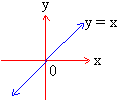-
 Constant
function: A function ' f ' is said to be f(x) = k, where k is
constant, is called a constant funtion.
Constant
function: A function ' f ' is said to be f(x) = k, where k is
constant, is called a constant funtion.
e.g. f (x) = 4, then f (-2) = 4, f (0)
= 4 and f (3) = 4
The graph of this function is a straight line
parallel to the x-axis.

-
Identity function: The function f(x) = x is
called an identity function.
The graph of this function is a line y
= x.
It is also One-One onto.
-
Step function: Let x is a real number. We denote
by the symbol [ x ], the greatest integer not greater than x
Clearly [ 5, 3 ] = 5, [ 7 ] = 7, [-1 ]
= -1, [-3.8 ] = -4. For a given real number x, [ x ] is
unique. Hence we consider f(x) = [ x ]. This function is called
the step function since its graph looks like steps. (For the
graph of this function see the solved problem 7).
-
Inverse function: Let y = f(x). It is one-one
and onto. Suppose we solve this equation and express y in terms
of x say x = f (y), then f(y)
is the inverse of f(x) and it is written as f -1,
i.e. x = f -1 (y)
e.g. i) If
y = 4x - 9, then x = 
Hence  is
the inverse of (4x-9)
is
the inverse of (4x-9)
ii) If y =  then x =
then x = 
iii) y = tan x
then x = tan-1 y or arc tan y
iv) y = ex
then x = logey